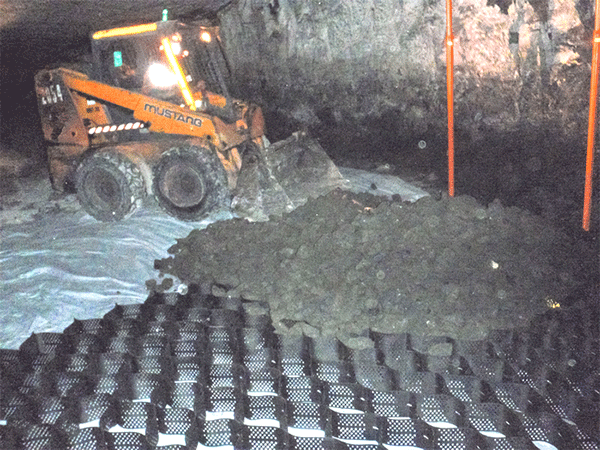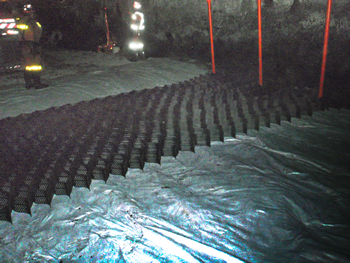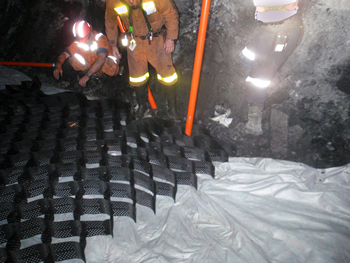 |
In underground coal mines, the mines prefer to leave a base of coal to leave a firm subgrade for traffic, however when coal seams are thin, in order to attain a minimum height to the roof, miners have to dig into the base and expose soft lenses of clay which have low bearing capacities. Consequently these frequently traversed pavements become impassable when mine vehicles, shuttle cars and mining machines create ruts which deepen over time and require maintenance to maintain access.
The presence of water from underground seepage as well as roof bolting and coal mining operations worsen the situation despite mines pumping many megalitres of water to the surface. This water transports fine sediments of clay and coal to the lower parts of the floor creating large areas of boggy conditions which can be impassable, making maintenance of these roads costly and can cause expensive delays to mining operations.
 |
Solutions such as concrete and cement stabilising these soft lenses is also expensive and creates problems when materials need to be transported underground especially from a manual handling point of view.
STRONGER ROADS, SAFER MINE
Geofabrics have been working with local coal mines around Newcastle to solve these pavement problems by developing solutions suitable for underground pavements. Drift pavements and diesel roadways are often constructed with loose ballast; however, due to the frequency of passes by shuttle cars, Eimcos and other traffic weighing 25–35 tonnes, the clay pumps through the ballast weakening the pavement and creating much the same problem as before.
Geofabrics suggested the pavement be constructed from a combination of bidim® nonwoven geotextiles manufactured in Australia, Geoweb®, a cellular confinement system and Tensar® geogrids to reinforce the pavement. The bidim® geotextile which has a high puncture resistance, acts as a separation layer that prevents the soft clays pumping up into the ballast pavement. The Geoweb® constrains the aggregate from moving laterally which increases shear strength and prevents wheel-path rutting thereby extending the life of the pavement significantly. In very poor sections where deep poor load bearing clays are weakened by water, it may be necessary to provide additional reinforcement by using Tensar geogrids. The ballast aggregate interlocks into the geogrid which prevents further lateral movement of the overlying ballast pavement and reinforces the road. As a result of these products, pavement stiffness is increased and differential settlements are significantly reduced.
 |
This creates a huge advantage for mining companies as any further maintenance of the road is unnecessary or may require minor correction periodically.
In all cases we recommend bidim® geotextile is used as a separation layer between the soft deposits and the structural ballast pavement. Over this, the Geoweb® panels are expanded and are held temporarily in place by “pogo-stick” braces between the floor and roof until the ballast material is placed into the cells. A skid-steer loader is useful to spread the ballast that the Eimco loader tips into the Geoweb® cells which then advances over the filled panels to create the pavement. The Geoweb® cells are slightly overfilled to form a strong stable platform. If required, Tensar geogrids are installed to further reduce differential settlements.
WIDE-SCALE ADOPTION
Since the initial trial at Chain Valley Coal Mine in 2006, bidim® nonwoven geotextiles and Geoweb® panels have been installed in other high maintenance areas, including drifts, diesel roads, intersections and curves. A number of other coal mines in NSW including Mannering Colliery, Mandalong, Austar, Tasman and Beltana Coal Mines have incorporated these solutions. Geofabrics has presented these mines with an economical alternative to traditional methods of pavements which were expensive and difficult to construct in underground applications. These solutions have also been adopted in some underground mines in Queensland and are rapidly being accepted by the mining industry as a solution for their pavements.
**
For further information and advice, mining companies are invited to contact Geofabrics Australasia to inspect and provide solutions that are site specific and can illustrate how these solutions substantially reduce problems in your underground pavements. www.geofabrics.com.au.











